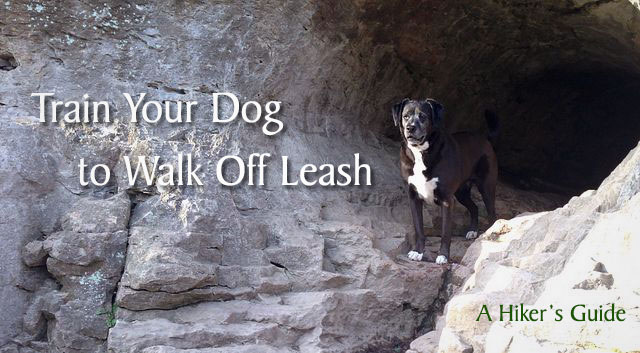 There’s only one thing that Haley loves more than playing with her basketball, and that’s going for an off-leash hike. The moment I let her loose, her eyes brighten, a smile spreads across her face and there’s a joyful bounce in her gait as she begins to connect with her wild, canine ancestors and become one with nature. She can run wild then stop abruptly to investigate any scent she pleases; she explores the world on her terms instead of at the end of a six-foot leash. It’s just as much fun for me too, watching her enjoy her freedom while I also have the freedom from being on my end of the leash.
There’s only one thing that Haley loves more than playing with her basketball, and that’s going for an off-leash hike. The moment I let her loose, her eyes brighten, a smile spreads across her face and there’s a joyful bounce in her gait as she begins to connect with her wild, canine ancestors and become one with nature. She can run wild then stop abruptly to investigate any scent she pleases; she explores the world on her terms instead of at the end of a six-foot leash. It’s just as much fun for me too, watching her enjoy her freedom while I also have the freedom from being on my end of the leash.
Trusting Haley to hike off leash didn’t happen overnight or even within the first year of her life. It took a lot of training and bonding time with her before I felt comfortable letting her have some freedom. There’s always an element of risk when you let your dog off leash, even with a well-trained dog with excellent recall, but the tips below can help you avoid some of the common problems you might run into when you train your dog to walk off leash.
10 Tips to Train Your Dog to Walk Off Leash
1. Understand your dog’s instincts.
Unfortunately, off-leash hiking is not for every dog. For example, some independent breeds are prone to run if let off leash, sight hounds and scent hounds that were bred to chase prey or follow scents may be harder to train and terriers may be more interested in chasing a small animal than the treat you’re carrying in your pocket. That’s not to say you can’t train any of these dogs to stay with you when off leash, but it may be more challenging to train some dogs. Unneutered male dogs that like to roam, aggressive or unsocialized dogs and dogs with extremely high prey drives are probably not good candidates for off-leash hiking. Every dog is different and even within a particular breed there are dogs that don’t fit the norm for breed description. You know your dog best and it’s important to consider all these factors before deciding if off-leash walking is right for your dog.
2. Make sure your dog has reliable recall.
Before attempting an off-leash walk with your dog, she must come to you reliably when called, even around distractions. And there are a lot of distractions when hiking off leash, new sights, sounds and scents all along the trail. The treat that got your dog’s attention in your living room won’t be very appealing compared to what nature has to offer. If your dog needs to work on recall, check out
Help! My Dog Doesn’t Come When Called for some tips. It’s also a good idea for your dog to be reliable with the
Sit and
Stay commands in case they’re needed on the trail.
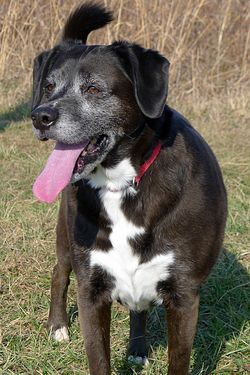
3. Practice off-leash walking in a safe area first.
Before you hit the trails, practice your dog’s recall in a fenced area or on a long leash. A dog park is a good practice location if you visit during off-peak hours. After your dog comes to you reliably, work in new areas that are safe but have more distractions. Practice sending your dog out to explore something nearby with the
Go command, then call her back and reward her for returning. Keep practicing until you’re confident with your dog’s recall skills.
4. Always have the right motivators to bring your dog back to you.
Be energetic and playful when you call your dog back. Always reward her with praise, treats or a favorite toy if she’s play motivated. It’s very important that you make it a fun and positive experience every time your dog comes to you, then release her to go right back and explore some more. If you only call your dog when it’s time to put her leash back on, she’ll learn not to come right away.
5. Select safe off-leash hiking areas.
Research hiking areas ahead of time and note any areas where dogs or off-leash dogs are not permitted. Most parks and trails are marked, but you could be fined if you’re caught walking off-leash where it’s prohibited. When exploring a new area or trail for the first time, have a trail map if possible and keep your dog on a leash until you know the area well. You don’t want your dog to be the first one to discover a cliff up ahead or have her jump into a fast moving river. Also, be aware of hunting and trapping seasons in national forests or other remote hiking locations and take precautions to avoid injuries. Have your dog wear a hunter’s orange or brightly-colored vest and keep your dog from wandering off the main trail.
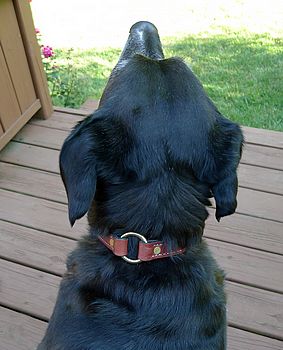
Center Ring Collar
6. Try using a center ring collar when hiking.
Also called a double ring collar, both types have a second ring on the back of the collar which makes it easy to quickly leash your dog when necessary. There’s no reaching under their chin or sliding the collar around to find the connector ring. While on the subject of collars, make sure your dog is wearing an ID tag in case she gets lost while hiking. If you do a lot of hiking or a lot of worrying about hiking with your dog off leash, a GPS tracking collar might be a good investment.
7. Leashing and unleashing your dog.
Wait until you’re in an area that’s safe (away from roads or other dangers) and where you feel comfortable before letting your dog off leash. When Haley’s off leash, I still carry her leash in my hand so it’s ready when I need it. We mostly like to hike on remote trails but out of common courtesy, I always leash Haley if we come across other hikers or dogs. Even if your dog is generally friendly with other dogs, you don’t know if someone else’s dog is going to be friendly. Always leash your dog in busy areas or if you feel uncomfortable with the environment.
8. Pay attention to your dog.
Be watchful of your dog at all times. She shouldn’t get too far ahead or too far behind you and she should never be out of your sight. You want her close enough that you can see if she suddenly starts to stray off the trail or if she comes across something gross like a dead animal carcass. Also keep an eye on the trail both ahead of you and behind you for other people and dogs. Joggers tend to catch me off guard sometimes, but I try to keep an eye out for them and leash Haley while they pass. If your dog is well trained and bonded to you, you’ll notice them keeping an eye on you as well. Haley usually hikes twice the distance as I do, because she’s constantly running ahead and then coming back to check in with me, but she always keeps an eye on where I am.
9. Be respectful of wildlife and nature areas.
Haley’s got a pretty good prey drive and there have been a few times where she bolted off the trail after a squirrel or herd of deer, but luckily she stopped quickly when I called her off the chase. I don’t want her to get lost by chasing something too far away and I feel we should respect the animal’s territory when we’re visiting their neck of the woods. Besides, she gets her fill of chasing wildlife when they happen to encroach into her territory in the backyard. Also, while bears do sh*t in the woods, we should pick up after our dogs if they do.
10. Keep reinforcing your dog’s recall.
Even though Haley’s been hiking off leash for most of her life, I continue to reinforce her recall skills by occasionally calling her away from interesting things and giving her lots of praise and rewards for listening. When she listens well in extreme situations when I know it’s very challenging for her to come to me or stay on the trail, she might get all the treats I have in my pocket! Try not to get aggravated by challenges you meet on the trail, such as running into other hikers or dogs. Every challenge is an opportunity for training that you usually can’t duplicate at home. I also like to keep Haley on her toes when she’s out in front of me by occasionally stopping, turning around and walking in the opposite direction or taking a different path when I reach a fork in the trail. It helps reinforce her need to watch me closely and stay tuned in to where I am and what I’m doing.
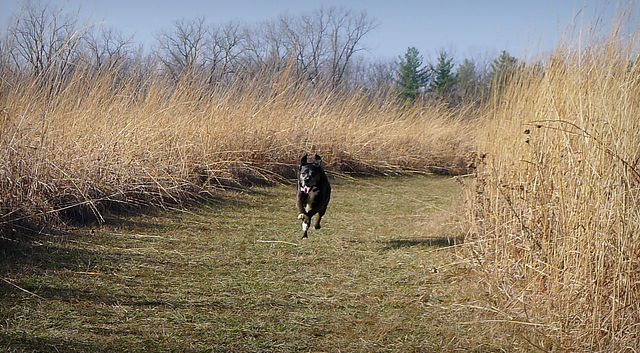 Off-leash hiking is my favorite activity to do with Haley. Even though there’s an element of risk and I know that no dog is 100 percent reliable in any situation, there’s something really special about being able to watch her just be a dog.
Off-leash hiking is my favorite activity to do with Haley. Even though there’s an element of risk and I know that no dog is 100 percent reliable in any situation, there’s something really special about being able to watch her just be a dog.
Do you enjoy off-leash hiking with your dog? Share your tips on how to train your dog to walk off leash!
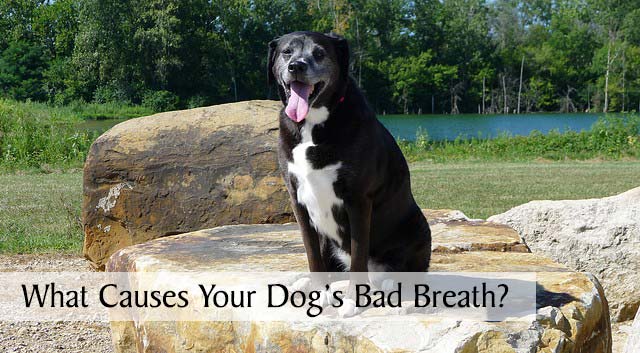 Does your dog have bad breath? When I was growing up, smelling a dog’s stinky breath was considered a normal part of having or being around a dog. We called it “doggie breath” and if we would have heard of someone back then brushing their dog’s teeth everyday, they surely would have been labeled as the “crazy dog lady” of the neighborhood. Today, more dog owners are starting to understand that a dog’s bad breath is usually a symptom of a brewing problem that should be checked out and treated.
Does your dog have bad breath? When I was growing up, smelling a dog’s stinky breath was considered a normal part of having or being around a dog. We called it “doggie breath” and if we would have heard of someone back then brushing their dog’s teeth everyday, they surely would have been labeled as the “crazy dog lady” of the neighborhood. Today, more dog owners are starting to understand that a dog’s bad breath is usually a symptom of a brewing problem that should be checked out and treated.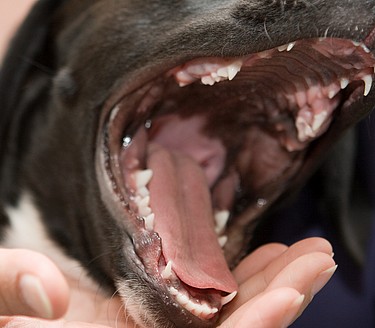
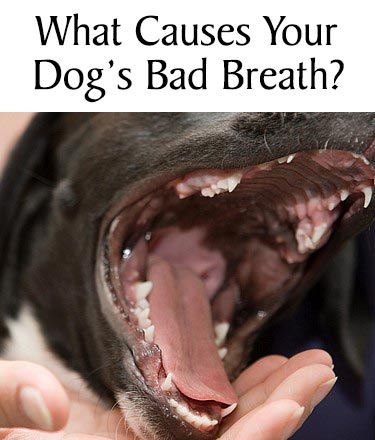

 I’ve been reading numerous articles lately about inconsiderate dog owners. All those rants and open letters made me realize that we focus a lot on how well our dogs behave, but not so much on how well we behave as dog owners. So, I’ve taken some common complaints and turned them into a quiz to see just how mannerly we are as pet parents. To check your dog etiquette and see how you compare to other dog owners, just click the ‘Start Quiz’ button below.
I’ve been reading numerous articles lately about inconsiderate dog owners. All those rants and open letters made me realize that we focus a lot on how well our dogs behave, but not so much on how well we behave as dog owners. So, I’ve taken some common complaints and turned them into a quiz to see just how mannerly we are as pet parents. To check your dog etiquette and see how you compare to other dog owners, just click the ‘Start Quiz’ button below.
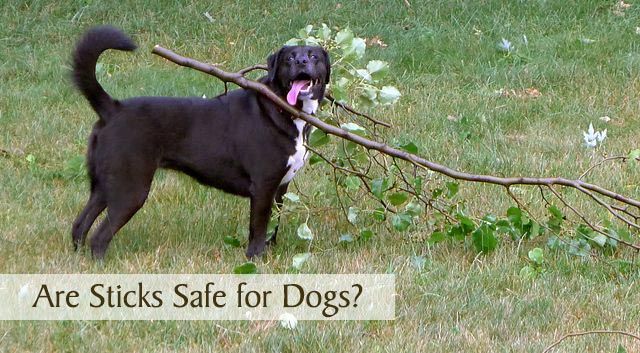 Like a lot of people, I grew up throwing sticks for my dogs to chase and I’ve done the same thing with Haley when hiking through the woods or playing on the beach. Throwing a stick for a dog seems like a natural thing to do and a lot of dogs like to chase and chew on sticks. Most people could live a lifetime with many dogs and never experience a problem from their dogs playing with sticks but if you ask your vet the question “Are sticks safe for dogs?” you’ll find out that it’s pretty common for dogs to become injured by them. Here are some things that can happen.
Like a lot of people, I grew up throwing sticks for my dogs to chase and I’ve done the same thing with Haley when hiking through the woods or playing on the beach. Throwing a stick for a dog seems like a natural thing to do and a lot of dogs like to chase and chew on sticks. Most people could live a lifetime with many dogs and never experience a problem from their dogs playing with sticks but if you ask your vet the question “Are sticks safe for dogs?” you’ll find out that it’s pretty common for dogs to become injured by them. Here are some things that can happen.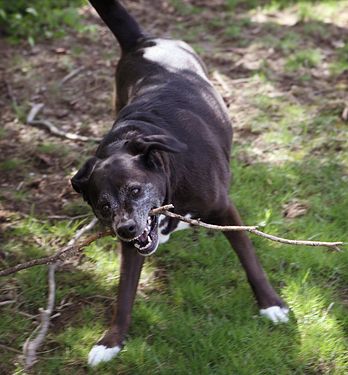 This is probably not as common, but it actually happened to Haley once. She likes to break sticks into pieces with her back molars. Those premolars are so efficient at shearing, she cut right through both sides of the stick and the piece left in her mouth became wedged between her top molars. In Haley’s case, I was able to reach in and remove the stick even though she was very frantic but I was lucky that she didn’t accidentally bite me in the process. Luckily, she was fine afterwards but sometimes a wedged piece of stick can cause injuries to the mouth.
This is probably not as common, but it actually happened to Haley once. She likes to break sticks into pieces with her back molars. Those premolars are so efficient at shearing, she cut right through both sides of the stick and the piece left in her mouth became wedged between her top molars. In Haley’s case, I was able to reach in and remove the stick even though she was very frantic but I was lucky that she didn’t accidentally bite me in the process. Luckily, she was fine afterwards but sometimes a wedged piece of stick can cause injuries to the mouth.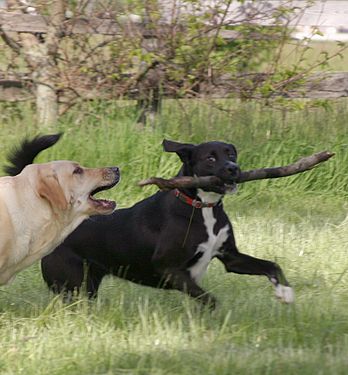 Haley’s favorite play buddy was my parent’s dog, Penny. They loved chasing after sticks together when we would visit the farm. Neither ever got hurt while chasing and wrestling with all those sticks, but like this picture illustrates, one quick cut in the wrong direction while another dog is trying to grab the stick could result in an injury. It’s a good idea to avoid throwing sticks in areas like dog parks where several dogs are romping, wrestling and competing for toys.
Haley’s favorite play buddy was my parent’s dog, Penny. They loved chasing after sticks together when we would visit the farm. Neither ever got hurt while chasing and wrestling with all those sticks, but like this picture illustrates, one quick cut in the wrong direction while another dog is trying to grab the stick could result in an injury. It’s a good idea to avoid throwing sticks in areas like dog parks where several dogs are romping, wrestling and competing for toys.
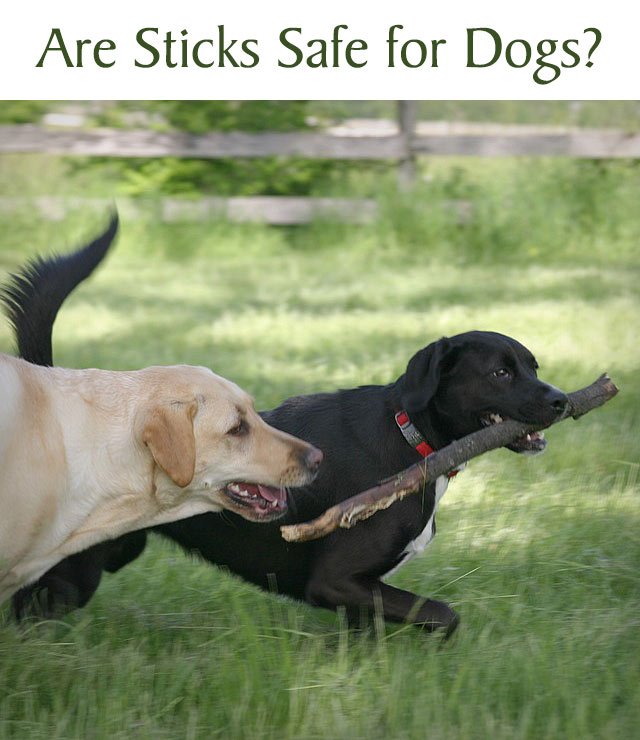
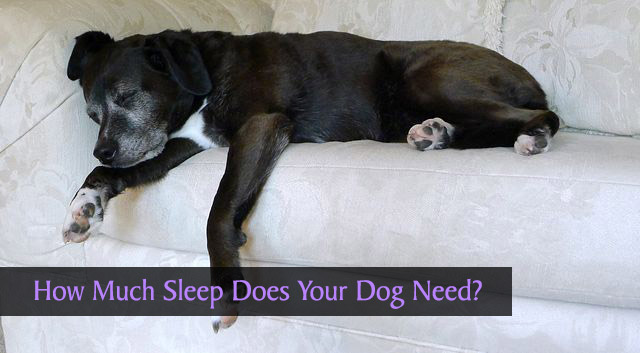 As I’m typing away here, Haley is sound asleep at my feet. She loves my blogging days much more than other days, like house cleaning day. On cleaning days, she follows me from room to room all day long. Maybe she’s inspecting my work as I vacuum all her black hair off the white couch or maybe she’s worried one of her de-stuffed toys will get caught in the belt of the monstrous, sucking machine. Nah, she follows me around because she’s a velcro dog who’s willing to forgo sleep in order to stay with me as I go about my dreaded domestic duties. No worries though, she certainly makes up for it by taking a few extra naps on my blogging days.
As I’m typing away here, Haley is sound asleep at my feet. She loves my blogging days much more than other days, like house cleaning day. On cleaning days, she follows me from room to room all day long. Maybe she’s inspecting my work as I vacuum all her black hair off the white couch or maybe she’s worried one of her de-stuffed toys will get caught in the belt of the monstrous, sucking machine. Nah, she follows me around because she’s a velcro dog who’s willing to forgo sleep in order to stay with me as I go about my dreaded domestic duties. No worries though, she certainly makes up for it by taking a few extra naps on my blogging days. 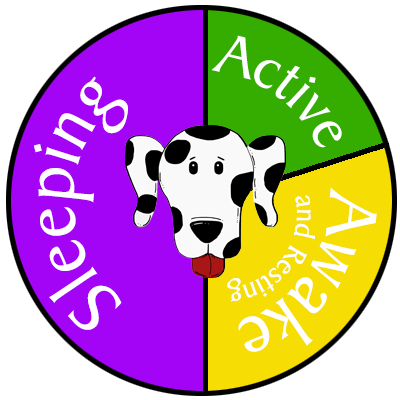

 There’s only one thing that Haley loves more than playing with her basketball, and that’s going for an off-leash hike. The moment I let her loose, her eyes brighten, a smile spreads across her face and there’s a joyful bounce in her gait as she begins to connect with her wild, canine ancestors and become one with nature. She can run wild then stop abruptly to investigate any scent she pleases; she explores the world on her terms instead of at the end of a six-foot leash. It’s just as much fun for me too, watching her enjoy her freedom while I also have the freedom from being on my end of the leash.
There’s only one thing that Haley loves more than playing with her basketball, and that’s going for an off-leash hike. The moment I let her loose, her eyes brighten, a smile spreads across her face and there’s a joyful bounce in her gait as she begins to connect with her wild, canine ancestors and become one with nature. She can run wild then stop abruptly to investigate any scent she pleases; she explores the world on her terms instead of at the end of a six-foot leash. It’s just as much fun for me too, watching her enjoy her freedom while I also have the freedom from being on my end of the leash.

 Off-leash hiking is my favorite activity to do with Haley. Even though there’s an element of risk and I know that no dog is 100 percent reliable in any situation, there’s something really special about being able to watch her just be a dog.
Off-leash hiking is my favorite activity to do with Haley. Even though there’s an element of risk and I know that no dog is 100 percent reliable in any situation, there’s something really special about being able to watch her just be a dog.